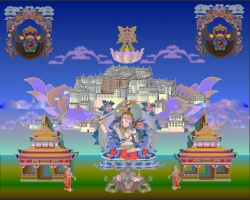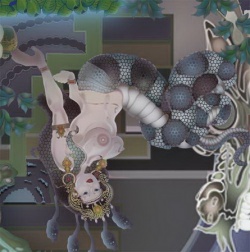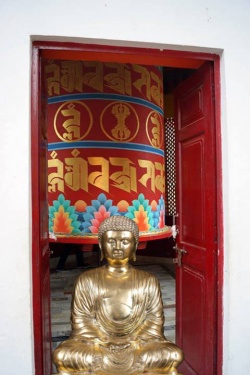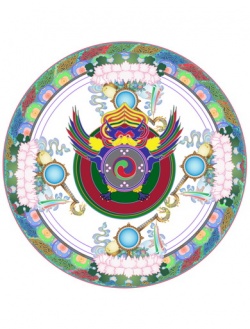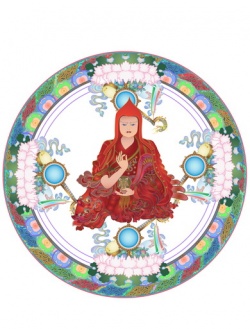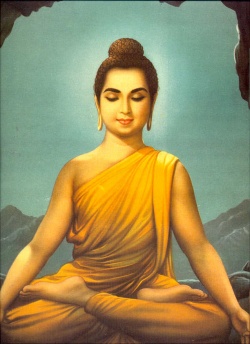Esoteric Buddhism in China
By Al Jigong Billings
When I was having lunch with Dr. Payne yesterday, he mentioned and recommended the work of Dr. Charles Orzech. Dr. Orzech is one of the few people studying esoteric Buddhism in China after the Tang dynasty.
Generally, in Japanese Buddhist thought, the high point of tantric Buddhism in China was during the Tang dynasty, when it was imported to Japan by Saicho (Dengyo Daishi) and Kukai (Kobo Daishi) of the Tendai and Shingon school, respectively. (Actually, they each founded those schools in Japan but let's not get into that here.) It is commonly thought that after the establishment of these schools in Japan and the ending of the Tang dynasty in China, that esoteric Buddhism died out. According to Orzech's work, this is not the case (which was largely news to me).
While looking for more information on Dr. Orzech, I found that he had actually lectured at IBS in April this year. The synopsis of his lecture is on the IBS site. I'll quote it below:
Esoteric Buddhism during the Song Dynasty (960-1279) The Tang Dynasty (618-906) is commonly depicted as the pinnacle of Buddhism in China. Likewise, the Tang is portrayed as the moment when Esoteric Buddhism briefly flourished in the court and was imbibed by the Japanese pilgrims Kukai and Saicho. Indeed, most treatments of Esoteric Buddhism in East Asia follow Kukai and continue their narrative in Japan with little or no reference to further developments on the Asian mainland. This is unfortunate, as Esoteric traditions in China continued to develop on a trajectory uninfluenced by Japanese developments. In this talk Prof. Orzech examines three important developments of Song Esoteric Buddhism. First he examines the renewed translation efforts by the first two Northern Song Emperors and their establishment of the Institute for the Translation of Scriptures (Yijing yuan). This effort, along with the production of the first printed canon, was part of a broader strategy to make the Song the center of Buddhist learning in Asia. Second, he explores evidence for the circulation and use of Esoteric scriptures and rituals recorded in the journal of the Japanese pilgrim Jojin on his visit to Wutaishan. Finally he looks at the integration of Esoteric themes, deities, and rituals in the Dazu region during the Southern Song.
As it turns out, his lecture was also recorded and is available on the IBS site. It is 91 MB in size so it is a tad large... If you are interested in this topic matter, it is definitely worth a listen though.
China of the T'ang Dynasty (A.D. 618-907) was then the most powerful country in the world. It is the most glorious chapter in the history of the Chinese people and has lasting influence even to these modern days. There are “T'ang Ren Jie” (literally, T'ang People Street) or China towns everywhere in the world. When overseas Chinese return to China they still say “Go back to T'ang Shan” (literally, T'ang Country).
The T'ang Dynasty Esoteric School, an important school of Mahayana Buddhism, originated in India and was introduced to China by the three Mahasattvas – Subhakarasimha, Vajrabodhi and Amoghavajra in the Flourishing Kai Yuan Period (A.D. 713—741) of the T'ang Dynasty. In the history of this school, there were many eminent monks who were not only virtuous and talented but also patriotic and compassionate. They had great influences on politics and the economy and made outstanding contributions to the Chinese culture. Master Yi Xing was a patriarch in the T'ang Dynasty as well as a world-famous scientist with notable achievements in the scientific field of mathematics, astronomy, geography and calendar. Master Amoghavajra, a famous translator in the history of Buddhism, made significant contributions to the promotion of cultural exchange between China and India; and as National Master, he played an active role in suppressing rebellions and creating prosperous and stable economy for the country. The Japanese monk, Master Kukai, who had come to study in China received the Dharma lineage of the school from the Seventh Patriarch Hui Guo; on returning to Japan he spread the Chinese Culture. He became the First Patriarch of the Japanese Shingon School and was also a major founder of the Japanese culture.
The T'ang Dynasty Esoteric School ceased its propagation in China after the late T'ang Dynasty. It was only in the beginning of this century that the teachings were re-introduced back to China from Japan. The Fiftieth Patriarch, Maha Acarya Feng Da An worked on and perfected Dharma teachings passed down from the previous patriarchs; his works, influential both in China and other countries, would enable modern people to understand the T'ang Dynasty Esoteric School. His only Dharma Successor, Maha Acarya Yang Fo Xing, has also published enlightening articles.
This website will provide the oral teachings, written works and biographies of patriarchs of the T'ang Dynasty Esoteric School. These articles are unsurpassable Dharma treasures and will provide Buddhism practitioners the means to self-realization.
Living Buddha Dechan Jueren, June 7, 2003
Lohan School of Shaolin, Las Vegas, Nevada
Translated by: Kuo
Transcribed by: Chang Zhi De Jian
Q: I have a question. I'm curious about the Taoist lineage that Master holds.
A: Hanmi school is actually a school, mainly it's a Buddhist lineage, however it incorporates Confucius and Taoist teachings, I do know a lot of the essence of Taoist teachings and practice. Buddhism and Buddha-Dharma, they are real siddhi power, they are magical practice, magical accomplishment, so goes for Taoism. For the accomplished practitioners of Taoism, their also you can call the Dharma, they are Taoist ways of magical siddhi powers, but however, very little of the Taoist real practice has been witnessed by the public, more people have witnessed Buddhist things but very few people have witnessed Taoist stuff.
What you know about the practice of Taoism for most people, having to do with the Feng Shui, or reading the stars, or doing some minor things, do a few chants and read a piece of paper with a sword, little stuff like that. Most Taoist practitioners do the Feng Shui and how to do life readings, and do fortune telling for people, this stuff is superficial practice, it's not the real essence of the teaching,
Around the year 720, those few years is during the Tang dynasty, Emperor Tang Xuanzong's time.
The three Buddhist masters, Subhakarasimha, Vajrabodhi, and Amoghavajra came to China, current day's Xian city. If you don't know where Xian is, I will tell you Xian is where in that region they have the first emperor of China's burial ground, Terra Cotta Armies, and they have over 100 pyramids, the largest one 300 meters, or over 1000 feet high, bigger than the one in Egypt.
When the three Buddhist masters came to Xian in the Tang dynasty, first it's a big cultural religious teachings clash, between Buddhism, against Taoism and the Confucius group, because during that time, the emperors afford the Taoist masters and the Confucius scholars the main teachings for the whole country as the national teachers, so in the Taoist practice, such thing as rain making, storm busting, and create winds, all about the art of war, how to lay out the troops and strategize. And all those kind of things.
They have to understand all about the I Ching Book of Change, understand about changing doorways, the doorways in the term of the Bagua, the Eight Tri Grams, there are 8 doorways, but there are inner 8 doorways and outer 8 doorways, and some of those doorways are not stationary, they move all the time. Certainly have a very profound knowledge, understanding about yin and yang, 5 elements and so on.
And they also understand the stars very well, I do not mean astrology, they physically have to look up at the sky at night, to be able to read the stars and understand the relationship with the earth change, how they correspond with the mountain and the river, certain topography of the earth and so on. These practitioners of Taoism are so good at reading the stars in such way, looking at the night sky and reading the stars, they understand about the ruler of that region, leader of a certain areas, certain geographic regions affected by the stars, how that people will live and so on, what's their life expectancy and everything. They understand about the changing of the stars in relationship to the fate of the people, and the fate of the nation.
Of course it's a common Taoist practice, commonly known, not necessarily mean everybody know how to do it, it called borrowing something to be something else, they call it move the flowers and plant it on the wood, and it will still grow flowers, or something like that. Or even some of the Buddha-Dharma you hear about, bring new spring to dead trees, those kind of Taoist practice they have too. And mostly commonly known is alchemy, holding a piece of rock and making it gold, are there really such things?
Or even in the Ucchus'ma teachings that they have this form of practice in Taoist teachings, backing up the ocean wave, or back flow the river course. And they understand the 5 element so well, it's called, they understand the transformational effects, they able to in a way transport themselves, following the property of the five elements, whether through the water, the fire, or earth and through the metal.
There's actually a common examination for the today's modern day Taoist too, you have to pass the exam to become a Taoist accomplished practitioner. First exam is you gotta climb the mountain of knife, bare feet, bare hand. Another exam is, you have to be able to walk on water. And certainly you have to be able to subdue wild animals, tiger, and dragons. And certainly you have seen some of the movies, Taoist masters can call the souls of dead people, and change the souls of people too. Prolonging life, just like Buddha-Dharma. Changing peoples luck. And certainly, if they know how to do all this, they know how to kill, in an instant. They can do a little practice, and make a person die, in 3 days or 7 days.
I told you all this not to tell you what I have, but I told you what I know how to do, these are the things I know how to do in the Taoist practice.
In the Confucius teachings, Confucius mostly focuses on family values, teachings, to be a righteous person, having respect for others and so on. So they have different traits, or teachings a person must follow,, such as compassion, etiquette, justice, in general all those good things you can come up with, respecting others, understanding how to clear out …?… and so on.
Most of the teachings are understanding relationships between superiors and subordinates, whether you are a superior or subordinate, you have to understand those relationships. Between father and son or mother and daughter, friends and brothers, it's not like people are born and understand. You have to understand how to have good relationship in that sense. (Kuo: He's summarizing too fast for me, only 5 Chinese words encompasses a lot of stuff)
Such as in the Confucius traditions certainly you know Book of Change, you have to be very good in mathematics, many forms, you have to be very good, and understand about principles, understanding about many disciplines such as society and customs, traditions, people and history. And how animal life comes to be and how they live their life, or expectancy of their life and so on, or plants. You have to understand all sorts of discipline, like biology and all this stuff, certainly understand about human bodies very well, so many good Chinese medicine doctors, traditionally, if they're good Chinese medicine doctor they're good Confucius follower, if they're Confucius follower, it means usually, they are a good doctor too.
I talk about all this different areas of disciplines in the Taoist and Confucius religions, these are the ones I know, these are the essence of the teachings, I talk to you very little about it. What do you know about Taoist, Confucius? Most people know about I-Ching and Book of Change, know about Bagua and basically, that's about it. But those are the simple stuff, those are the simple tools that you have to know the basic lessons. There are many things that have never been taught to the public at all.
Why is it that they cannot be taught widely to many people? Because all these things I describe to you, I know how to do. I really know how to do it. It cannot be taught lightly to anybody because until you overcome your animal nature, you're habit of laziness, you have to really subdue your ego totally, you cannot learn those kind of things. If you have a tiny tinge of ego, certainly you will retain this kind of, advantaging for yourself, if you know how to do this kind of things, then it will be bad for you. This kind of, want to revenge, take revenge on others if they do you injustice, some days, you may say its ok, but some it's really not good …?… a bigger disaster.
Now, of course I don't know whether some of you already know, last year we have 100 day Dharani teachings, many of my disciples attend that teachings, really can do things, they can make rain or stop storms, put out forest fires and so on. For those that attend that 100 day teaching, a forest fire, they can put out a forest fire easy. Now, if those who attend this 100 day teaching, let me make this a little bit clearer to you. If let's say you learn this mantra, you apply the technique, and you can put out a wild fire. Isn't that so, if you can tweak the mantra a little bit, apply it slightly different ways, a variation from the techniques that you putting out fire, you can actually use that, and put somebody's house on fire. It's the same thing, there's no difference. Only tweaking it a different way. It's the same mantra, same technique, except you don't know the variation of that.
There some of you have also seen if I turn on the stove and gas is coming out but it's not lighting up, lighter is dead, then usually you have to take a lighter and put the fire on there, but many times I don't use the lighter, I just turn the gas on and swing my hand over it, and the fire will start.
So what happened during the Tang dynasty, you know, Hanmi School started during the Tang dynasty by Subhakarasimha Vajrabodhi, and Amoghavajra, the 3 Buddhist masters, came to China, in the beginning they certainly face a lot of difficulties, big culture and religious and discipline clash with the Confucius and Taoist.
However, these 3 Buddhist masters have great heart, and they able to accept and learn and incorporate many of the Taoist and Confucius teachings into their own school. And they mature this incorporated, or assimilated new disciplines into the school we call Hanmi Buddhism, or the Chinese Esoteric School. Actually incorporated Buddhism, Taoism and Confucianism.
However, I will add something more for you. Amoghavajra was one of the greatest translators from Sanskrit to Chinese. He's actually a Sri Lankan, a Singhalese, if he's so good at doing translation, certainly he had to learn a lot of Chinese culture and language, therefore, he definitely learned a lot of Taoist and Confucius teachings.
Mater: If there's no more questions, I certainly hope to see everyone tomorrow, come and learn the Medicine Buddha. Thank you.
